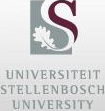Prof Corné Coetzee from the Department of Mechanical and Mechatronic Engineering at Stellenbosch University recently delivered his professorial inaugural lecture, titled 'Modelling of granular materials: Discrete and continuum approaches'. He spoke to the Division of Corporate Communication and Marketing about how the software tools that he develops are used to improve the handling of granular materials in the mining and agricultural sectors.
Tell us more about your research and why you became interested in this specific field.
When growing up, my family had a construction business with large earthmoving equipment. At first, it got me interested in the mechanical aspects of it. Hence, after school I studied mechanical engineering. Until late in my undergraduate studies, I wasn't sure what I would do after completing my studies. However, for my final-year research project, I worked on improving our understanding of the behaviour and flow of granular materials (particles) – something closely related to the earthmoving activities I often witnessed as a child. When I started with this project, my passion for research became immediately clear, and I had no doubt as to continue with a Master's degree and a PhD on the same topic.
Today, the focus of my research is the development of numerical tools (computer software) that can model and predict the behaviour of granular materials for applications in geotechnical engineering and bulk solid handling.
How would you describe the relevance of your work, especially for our South African context?
The software tools that we develop are used during the design phase so that improved bulk handling equipment can be designed, and also for solving problems with existing equipment where the performance is not as required. Applications are mainly in the mining and agricultural sectors – important role players in the South African economy and food security. In these sectors, most of the materials are in a bulk solid form, i.e., granular. Examples include conveyor belts and conveyor transfer chutes, and all equipment used for the handling, storage, transportation and processing of mined ore and agricultural products such as corn and wheat grains.
Can you tell us more about the impact of your research?
Improved equipment design means more energy-efficient equipment, less waste and pollution and higher production rates.
Which aspects of your work do you enjoy the most?
I mostly enjoy the challenge of solving problems, the unknown, going where no one has gone before – it feels like an adventure of discovery. Someone once said, “all models are wrong, but some are useful". Our models are based on natural phenomena through observation and measurement. Hence, with each new discovery, even the very small ones, we learn a bit more and can improve our models systematically.
The pandemic has changed the way we work and live. What has kept you motivated during these times?
The pandemic had no significant effect on my work or life. Knowing that it should at some stage return to normal, I simply continued with my academic activities.
How do you spend your free time away from lectures and research?
I love mountain biking, and with the magnificent Stellenbosch trails, I do my best to go riding after work, two to three days a week all year round. Not only does it keep me fit, but I can also clear my head without any interruptions. We also love to visit our neighbouring countries, mainly Namibia and Botswana for camping holidays.

